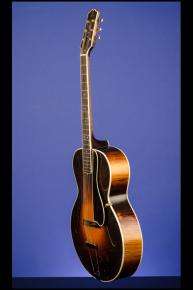A Lovely Late Twenties Gibson L-5.
1929 Gibson L-5 (second variation).
This exceptionally fine 16 inch wide and 3 3/8 inch deep, highly important and very rare archtop guitar weighs just 4.60 lbs. Two-piece carved spruce top with two-piece book-matched flamed curly back and curly maple sides. Two-piece book-matched curly maple neck with center mahogany strip, and single-bound ebony fretboard with a small, graceful point at the end. Twenty original thin frets, and inlaid pearl dot position markers (starting at the fifth fret) and black dot side markers. Triple-ply binding on the top and back of the body. Earliest style 'unbound' f-holes. Triple-bound, walnut faced headstock with the "The Gibson" script mother-of-pearl logo inlaid horizontally across the face of the headstock and with the mother-of-pearl "L-5" flowerpot inlay below. Black headstock rear with widow's peak. Original individual Waverly silver-plated open-back tuners with oval metal buttons. Black plastic bell-shaped truss-rod cover with two screws. Original tortoise shell-like plastic pickguard with white three-ply celluloid binding. Original height-adjustable ebony bridge with pre-set compensating saddle on original ebony base. This important piece of musical history is in excellent plus (8.75) condition. We believe that the tailpiece has been replaced - there are three additional screw holes under the tail-bracket which have been filled. Two of the worm-gear screws (Low E & D) have been replaced as well as the 'side' screw on the pickguard bracket. inside the bass 'f' hole is the Gibson 'white' oval label with Style "L-5" and serial number "90315" stamped in black. Inside the treble 'f' hole is the FON (factory order number) "796" stamped in black. There are a few surface marks and some considerable playing wear on the back of the neck. There are no cracks or repairs and the guitar plays very comfortably and exhibits a warm, sweet, rather mellow tone with lots of sparkle. Housed in its original four-latch shaped black hardshell case with dark green plush lining (8.50).
"The L-5 was designed as an accompaniment for orchestra, small group, and solo settings. At the time of its introduction, there was no other guitar made by any manufacturer that even remotely resembled the L-5 in overall form or function. Soon after its auspicious debut in 1923, the L-5 became one of Gibson's all-time great guitars, a milestone in the evolution of the carved-top instrument and a major contributor to American acoustic and electric music. The L-5 was designed by a special engineering team led by Lloyd Loar and was part of a product line that included the F-5 mandolin, the H-5 mandola, and the K-5 mandocello. Of these four instruments, the L-5 guitar and the F-5 mandolin became outstanding performers and prized instruments valued by players and collectors alike… The first L-5 guitar was introduced in late 1922. This instrument, with a lower bout width of 16 inches, was essentially produced in three variations before it was substantially altered in 1934 to become the Advanced L-5. These three variations consist of the first L-5 guitars of 1923-1924, which contain two labels inside the body. One of these labels was signed by Lloyd Loar, along with the date, model designation, and serial number. These L-5s are the "Lloyd Loar" L-5s, although the second variation of the 16-inch L-5 is essentially the same in construction, but without Lloyd Loar's signature on one of the two inside labels. The second variation usually does not contain the Virzi tone producer that was offered in the first L-5s only in 1924. The third variation of the 16-inch L-5 was introduced in late 1929, when the fretboard inlays were changed from simple pearl dots beginning at the third fret to large rectangular pearloid block inlays." (Tom Van Hoose. The Gibson Super 400, pp.99-101).











